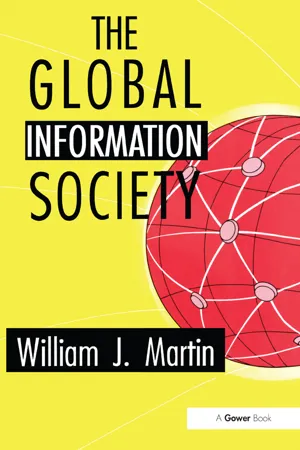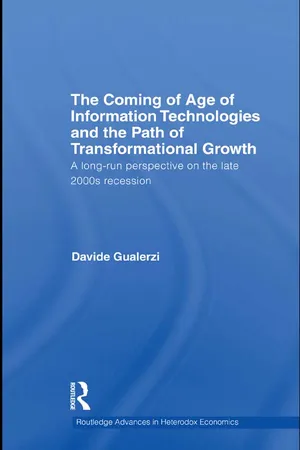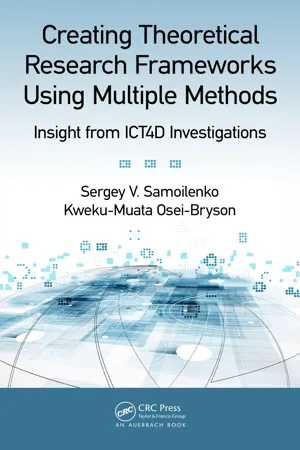Economics
What is Information Technology
Information technology refers to the use of computer systems, networks, and software to manage and process data. It encompasses a wide range of technologies, including hardware, software, and telecommunications, and plays a crucial role in facilitating communication, data management, and automation in various economic activities. Information technology enables businesses to streamline operations, improve efficiency, and access and analyze data for decision-making.
Written by Perlego with AI-assistance
Related key terms
8 Key excerpts on "What is Information Technology"
- eBook - ePub
- Peter Johnson(Author)
- 2002(Publication Date)
- Routledge(Publisher)
Chapter Seven Information TechnologyPAUL STONEMAN
7.1 INTRODUCTION
7.1.1 Some Definitions
Although information technology is a term that has entered common usage over the last ten years it is rarely defined precisely. The following definitions adapted from Porat (1977) are used here: information is data that have been organized and communicated; the information economy is that part of economic activity that involves the production, processing and distribution of information goods and services and the provision of inputs thereto. Thus, for example, within the firm it includes such activities as research and development, managerial decision-making, market research, filing invoices, data processing and telephone communication. In the wider context such activities as telecommunications, education, the arts and the media may also be included. The sorts of products involved in the information economy include not only computers, but also television, radio, hi-fi systems, telecommunications systems, word processors, videos and many related goods. Information technology is the pattern of products produced by and processes used in the information economy. The media conception of information technology as related to recent advances in, and the convergence of the interrelated fields of, micro-electronics, fibre optics, software engineering, communications, and computer technology, is encompassed within this definition.It is useful to split the information economy into two separate parts, the primary information sector (PIS) and the secondary information sector (SIS). The definitions of these sectors is taken from Organization for Economic Cooperation and Development (1986). The PIS (p. 16) includesgoods and services which intrinsically convey information (such as books), or which are directly useful in its production, processing or distribution (such as computers). These goods should normally be transacted on established markets for inclusion in the PIS. The PIS is therefore the productive locus of an information based economy, providing the technical infrastructure for a variety of information processing and transmission activities (as with telecommunications networks), as well as offering information goods and services for sale directly as a commodity (as with video recorders and software consultancies). - eBook - ePub
Economic Systems Analysis and Assessment
Intensive Systems, Organizations,and Enterprises
- Andrew P. Sage, William B. Rouse(Authors)
- 2011(Publication Date)
- Wiley-Interscience(Publisher)
The Internet, World Wide Web, and networks in general have become ubiquitous in supporting these endeavors. However, organizational productivity is not necessarily enhanced unless attention is paid to the human side of developing and managing technological innovation to assure that systems are designed for human interaction. These are, of course, major objectives for systems engineering and systems management.There are several ways in which we can define IT. The U.S. Bureau of Economic Analysis appears to define it in terms of office, computing, and accounting machinery. Others consider IT as equivalent to information processing equipment, which includes communications equipment, computers, software, and related office automation equipment. Still others speak about the technologies of the information revolution and identify such technologies as advanced semiconductors, advanced computers, fiber optics, cellular technology, satellite technology, advanced networking, improved human computer interaction, and digital transmission and digital compression. We would not argue about the content in this list, although we would certainly add software and middleware technology to this list. It could be argued that software is intimately associated with advanced computers and communications. This is doubtlessly correct; however, there is still software associated with the integration of these various technologies of hardware and software to comprise the many IT-based systems in evidence today and which will be in use in the future.The information revolution is driven by technology and market considerations and by market demand and pull for tools to support transaction processing, information warehousing, and knowledge formation. Market pull has been shown to exert a much stronger effect on the success of an emerging technology than technology push. There is hardly any conclusion that can be drawn other than that society shapes technology or, perhaps more accurately stated, technology and the modern world shape each other in that only those technologies that are appropriate for society will ultimately survive. - eBook - ePub
- William J. Martin(Author)
- 2017(Publication Date)
- Routledge(Publisher)
20 The economics of information networks is now emerging within a broader economic theory of information production and use, including such components as:– the economics of the generation of technological innovations;– the economics of diffusion of technological innovations;– the economics of market competition;– regional economics;– the theory of industrial organization;– the theory of the firm.20Something of the contribution of these developments can be gauged in terms of their impact upon firms, regions and markets. One aspect is the tendency for externalities or forms of direct interdependence among the members of an economic system that do not operate through the market mechanism or that are not fully mediated by prices. Externalities are thought to arise when growth investments and technological change in an industry cause capacity expansion and decline of product prices and factor costs. These externalities affect the behaviour of firms supplying those productive factors and using those products. Often clusters of industries emerge around the externalities spilling from core technologies and make it possible to increase the levels of productivity and competitiveness of all the firms which interact in the flows of exchanges of goods, services and information. Moreover, the increased availability of skilled manpower and the opportunities for training and learning benefit the other firms within the economic system.20Another outcome can be the emergence of network firms to take advantage of externalities and increase the level of appropriability of the benefits of technological innovation and reduce the public goods character of knowledge. Network firms are characterized by interlocking directorates, long term contracts, joint-ventures, cross-licensing, technology clubs and swapping of minority stakes. They can also serve as structures which enable organizations to learn from the selective integration of localized learning opportunities on the network. Co-operation among such firms is selective and revolves around certain well-defined tasks and objectives, with safeguards built into the system to prevent abuse.20 - eBook - ePub
- Frank Webster(Author)
- 2014(Publication Date)
- Routledge(Publisher)
Many studies have shown how technologies bear the impress of social values, whether it be in the architectural design of bridges in New York, where allegedly heights were set that would prevent public transit systems accessing certain areas that could remain the preserve of private car owners; the manufacture of cars which testify to the values of private ownership, presumptions about family size (typically two adults, two children), attitudes towards the environment (profligate use of non-renewable energy alongside pollution), status symbols (the Porsche, the Mercedes, the Skoda) and individual rather than public forms of transit; or the construction of houses which are not just places to live, but also expressions of ways of life, prestige and power relations, and preferences for a variety of lifestyles. This being so, how can it be acceptable to take what is regarded as an asocial phenomenon (technology) and assert that this then defines the social world? It is facile (one could as well take any elemental factor and ascribe society with its name – the Oxygen Society, the Water Society, the Potato Age) and it is false (technology is in truth an intrinsic part of society), and therefore ICT' separate and supreme role in social change is dubious.Economic
This approach charts the growth in economic worth of informational activities. If one is able to plot an increase in the proportion of gross national product (GNP) accounted for by the information business, then logically there comes a point at which one may declare the achievement of an information economy. Once the greater part of economic activity is taken up by information activity rather than, say, subsistence agriculture or industrial manufacture, then it follows that we may speak of an Information Society (Jonscher, 1999).In principle straightforward, but in practice an extraordinarily complex exercise, for which much of the pioneering work was done by the late Fritz Machlup (1902–83) of Princeton University (Machlup, 1962). His identification of information industries such as education, law, publishing, media and computer manufacture, and his attempt to estimate their changing economic worth, has been refined by Marc Porat (1977b).Porat distinguished the primary and secondary information sectors of the economy. The former is susceptible to ready economic valuation since it has an ascribable market price, while the latter, harder to price but nonetheless essential to all modern-day organization, involves informational activities within companies and state institutions (for example the personnel wings of a company, the research and development [R&D] sections of a business). In this way Porat is able to distinguish the two informational sectors, then to consolidate them, separate out the non-informational elements of the economy and, by reaggregating national economic statistics, is able to conclude that, with almost half the United States’ GNP accounted for by these combined informational sectors, ‘the United States is now an information-based economy’. As such it is an ‘Information Society [where] the major arenas of economic activity are the information goods and service producers, and the public and private (secondary information sector) bureaucracies’ (Porat, 1978, p. 32). - Davide Gualerzi(Author)
- 2009(Publication Date)
- Routledge(Publisher)
These are significant structural change effects. However, the impact of ICTs growth and increased sophistication, thus of the Internet, on the economic structure at large appears to be the most important issue, one which received little attention in the economic literature. One of the main consequences is the possibility of increasing returns originating in what we call the “network effect”.5.5 Increasing returns: the network effect
It can be noticed how the debate on information technologies and the US economy focuses on a fairly narrow definition of information technology. The bulk of the argument is built around information-processing, i.e., generating and utilizing computing capacity, and its impact on productivity growth. This suggests a certain lack of appreciation of the main novelty of the 1990s, the Internet. Indeed, there is little elaboration of the implications of the spread of the Internet for growth patterns in the economic literature on the 1990s. Still, the pivotal role played by ICTs cannot be understood unless we consider the importance achieved by the communication link, meaning that the information-processing capabilities are now interconnected in a network.7 Essential to an understanding of the impact of ICTs on the economic structure is a full appreciation of the relevance of the combination of information-processing with telecommunications, on which the development of the Internet depends. Advanced telecommunications and “broadband” access enlarge the capabilities of the communication link, which is part of the technological layer of the Internet.The development of networks, and of the Internet in particular, is fundamental to the transformation of the years of the New Economy, not to mention its long-term consequences. It had a general impact on the economy, via the possibility of reorganizing productive processes, the transaction of goods and services, the development of network externalities, and ultimately the creation of new products and services. That takes us beyond the fundamental scheme underlying the debate on productivity growth, into the broader perspective of the process of structural transformation associated with the ICTs frontier.- eBook - ePub
The Essential Manager
How to Thrive in the Global Information Jungle
- James W. Cortada(Author)
- 2014(Publication Date)
- Wiley-IEEE Computer Society Pr(Publisher)
Chapter 3 ) continues to explore the role of industries.Information Technologies to Pay Attention to Right Now
As one comes to understand how your firm works within its business ecosystem of industries, customers, regulators, and national economies, the importance of IT becomes intuitively obvious. But since IT keeps changing and affecting the performance of companies and government agencies, we have to keep watching what the technologists are up to. Every “expert” has her list, I have mine, and it changes every few years because of the evolution of IT. In the immediate past few years, readers have surely heard about analytics, big data, security systems, sensors, the Internet of course, social media, and mobile communications. All are important, each is still transforming, and none have played out their full effects on firms, work, or whole industries and economies. But you already know that and by this point in the book, know to keep watching developments in those spaces. But, now for a few that are on the horizons about which we hear very little outside of the technical communities, but will “go public” over the next 5 years in ways that possibly could disrupt some businesses, will deliver new niche opportunities for revenues and profits and that will change the nature of how and who does work. Each will take time to flower in the fullness of their capabilities and so should be ongoing stories for managers, consultants, academic researchers, and the media to discuss for at least two decades, which is about the amount of time it takes for a new technology to have widespread effects on organizations and people. But let us begin with one already now, but slowly, making its way into the world of management: cloud computing. - eBook - ePub
Governance, Growth and Global Leadership
The Role of the State in Technological Progress, 1750–2000
- Espen Moe(Author)
- 2016(Publication Date)
- Routledge(Publisher)
Chapter 6Information and Communication Technologies
A World Economy in Transition: ICTs and Globalization?
This chapter has to be of a more speculative nature than the previous four, since the focus with respect to information and communication technologies (ICTs) and industries is on developments that are still in the present and to some extent in the future. During the 1970s and early 1980s, several scholars (e.g. Kennedy 1989) predicted the decline and fall of the US, based on decreasing shares of world manufacturing output, falling labor productivity and defense expenditures far superseding those of its nearest rivals. The 1990s instead saw the US re-establish itself as the number one economic (and military) power, with Japan since 1990 stuck in a more or less continuing recession. A crucial reason for this is the success that the US has experienced in ICTs. While both the US and Japan are highly successful ICT producers , only the US has been able to successfully utilize its ICTs. This has greatly boosted the economy and propelled the US on a most impressive growth spurt.ICTs and ICT industries are the obvious choice for a present-day leading sector. First; while aware of the hype that has surrounded ICTs, especially up until the dot.com bubble burst in 2001, ICTs have spawned exceptionally rapidly growing industries. Over the past few years, we have seen ever more evidence pointing in the direction that ICTs are having a strong positive impact on productivity figures (TFP, labor productivity), especially in the US. There is a large, and growing, literature emphasizing the importance of ICTs for present and future growth and development (e.g. Castells 2000a; Freeman and Louçã 2001; Mowery and Rosenberg 1998; Nelson 1996; OECD 2001a; Perez 2002).Second, ICTs have one characteristic central to most influential technologies; its generic nature. It is becoming ever more evident that the main boost to national economies around the world does not stem primarily from computer manufacture (or other ICT producing industries), but from the utilization of ICT services - eBook - ePub
Creating Theoretical Research Frameworks using Multiple Methods
Insight from ICT4D Investigations
- Sergey V. Samoilenko, Kweku-Muata Osei-Bryson(Authors)
- 2017(Publication Date)
- Auerbach Publications(Publisher)
16 Understanding the Human Capital Dimension of Information and Communication Technology and Economic Growth in Transition EconomiesIntroduction
An important stream of research in the economics of information systems (IS) is the investigation of the relationship between investments in information and communication technologies (ICTs) and macroeconomic outcomes (Colecchia & Schreyer 2002; Pohjola 2002; Kraemer & Dedrick 2001). Many of these studies provide compelling evidence that ICT expansion and use have led to robust returns and economic growth in developed countries (OECD 2005; Oliner & Sichel 2002; Jalava & Pohjola 2002). In other contexts, research is scarce, and similar studies of emerging, developing, and transition economies (TEs) reveal significantly lower levels of returns on investments in ICT (Dewan & Kraemer 2000; Pohjola 2001; Piatkowski 2003). It is important to note that while TEs share important economic characteristics, they differ from developed countries in terms of their levels of intensity of using ICT, competition and regulatory environments, relative costs of deployment of technology, quality of human capital, and flexibility of the business environment (OECD 2004). Consequently, insights obtained by analyzing the existing studies of developed economies cannot be applied easily to TEs, or to emerging and developing economies. As a result, researchers have suggested that more studies on global IT management in developing, emerging, and transition economies (Palvia 2006) are needed to identify specific factors inhibiting these economies from sharing similar levels of returns on ICT investments as developed countries (OECD 2004).Despite the calls for additional studies, research on these issues remains sparse and scattered (Palvia 2006). One of the commonly noted reasons for the dearth of studies is the limited availability of reliable time series data (Hoskisson et al. 2000). Another challenge is the absence of a common taxonomy that clearly differentiates emerging, developing, and transition economies (Samoilenko 2008). While emerging, developing and transition economies are clearly distinct from developed economies, these countries do not represent a homogenous group (Roztocki & Weistroffer 2008; Hoskisson et al. 2000). Consequently, the widely cited in-depth case studies about ICT successes in selected developed countries are not generalizable to emerging, developing, and transition economies. Some researchers argue that to obtain a deeper understanding of the impact of ICT investments on macroeconomic outcomes, longitudinal studies are needed (Palvia 2006; Hoskisson et al. 2000); others suggest various levels of group analysis (Bagchi & Kirs 2009). However, even with reliable time series data from trusted public sources, researchers face two main challenges. The first challenge is associated with constructing a relatively homogenous sample from a heterogeneous population of emerging, developing, and transition economies, and the second challenge is represented by the general scarcity of theory-driven approaches and methodologies for analyzing samples of convenience and identification of relevant economy-specific antecedents.
Learn about this page
Index pages curate the most relevant extracts from our library of academic textbooks. They’ve been created using an in-house natural language model (NLM), each adding context and meaning to key research topics.







